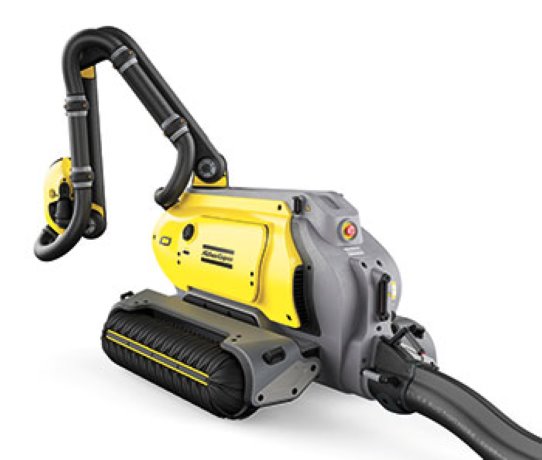A robot that "erases" concrete buildings got a thumbs-up from the Industrial Designers Society of America, who gave its designer a gold award in the student category.
The yellow and grey machine, named ERO, looks similar to a heavy-duty vacuum, and has the potential to quickly take down concrete structures, separate the material and render a large portion of the material as recyclable.
“ERO can create an asset instead of waste,” said its designer Omer Haciomeroglu, via Skype, from his home in Istanbul, Turkey.
What he means is that ERO has the ability to separate aggregate from the cement and rebar.
The aggregate, undamaged and cleaned, is ready to be re-purposed, said Haciomeroglu, who has a master’s degree in advanced product design from Ume Institute of Design in northern Sweden.
Working with engineers, it took five months to design ERO, which was Haciomeroglu’s thesis project.
The robot remains in the design stage and Haciomeroglu hasn’t been able to get a company to put up money to build the prototype of ERO.
“Those in the concrete industry see the potential,” he said.
“No one said it’s a crazy idea. All the technology exists. It just needs to be engineered and tested.”
ERO’s name comes from “erosion,” in this case, using water to wear away the concrete.
With the world population and mega-cities growing at an unprecedented rate, Haciomeroglu wanted to find a more economical and environmentally-sustainable way of taking down and rebuilding concrete structures, as the demand for more living and working space increases.
Sending less waste to landfills was also an important consideration.
“We have to find a smart way to rebuild,” said Haciomeroglu, whose father is an architect.
Before starting, the robot scans the building to determine the best way to proceed.
Rather than the typical method of using large amounts of water to keep dust down and expending a lot of energy and brute mechanical force to crush the concrete, ERO would use highly-pressurized jets of water to crack the building’s concrete surface.
It then sucks and separates the mixture of aggregate, cement and water.
The water is re-filtered and returned to the blasting system.
Aggregate and filtered cement slurry are sent separately to a packaging unit to be contained.
Clean aggregate is packed into labelled bags, ready for re-use.
The standing rebar meanwhile, gets cleaned of rust and dust by ERO’s high-powered jets of water.
“The rebar is then like brand new material,” Haciomeroglu said.
“You can cut it, use as is. It can also be melted down.”
Only a handful of people are needed on site to supervise the handling and distribution of the deconstructed materials.
A professor at Simon Fraser University’s School of Engineering Science said Haciomeroglu has a lot of good ideas, but the project has many components, with some areas lacking detail.
“There’s not a lot of detail on the filtration process,” said Professor Shahram Payandeh. “It would be nice to hear more.”
Given that the robot is to work autonomously, Payandeh said detail is also lacking about how that would occur.
“You need cameras, sensors to make the robot aware of its environment,” said Payandeh, whose speciality is robotics and systems design.
In a construction environment, full of moving machinery and people, it can be difficult to align equipment.
As for water-jet cutting, the technology already exists, Payandeh said.
It’s a matter of connecting the water jet to another piece of machinery, such as a mini-bobcat.
Overall, Payandeh applauded the clever ideas in Haciomeroglu’s design, but the mechanical challenges of having the robot work autonomously in a demanding environment and the lack of clarity on how the waste products would be handled left the professor with questions.
Even with those questions, Haciomeroglu, who studied design for two years at California State University in Long Beach and later received his bachelor’s degree in industrial design from Istanbul Technical University in 2007, has been getting orders for ERO from around the world.
Usually a couple queries each day cross his desk from places like Austria, China, Portugal, Brazil, Kazakhstan and the U.S.
But Haciomeroglu stressed that ERO is only at the concept stage.
A Swedish company is interested, but Haciomeroglu said that it takes a lot of time and money to reach a deal.
“This project is so big, it needs a huge resource,” he said.
Until an actual ERO is built, Haciomeroglu won’t know what it would cost to build what the retail price would be.
More Concrete:
- VIDEO: Brian Hubbs of RDH Building Engineering on insulating concrete forms
- Building green with the help of concrete
- Carbon tax may give unfair advantage to foreign cement
- Concrete toboggans take the plunge
- Arctic concrete pour defies subzero work conditions
- Future of 77-year-old Pattullo Bridge is still up in the air
- Concrete industry unites to spread sustainability message
- Insulating concrete forms hailed as efficient solution
- Reports delve into concrete’s role in infrastructure renewal
- Lafarge, Holcim in talks to merge the world’s two largest cement companies



Recent Comments
comments for this post are closed